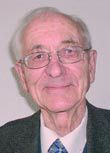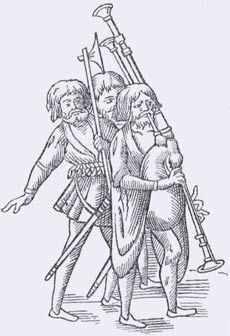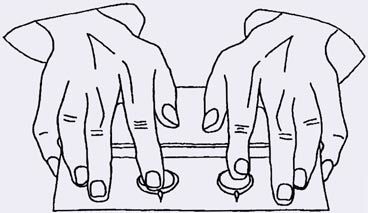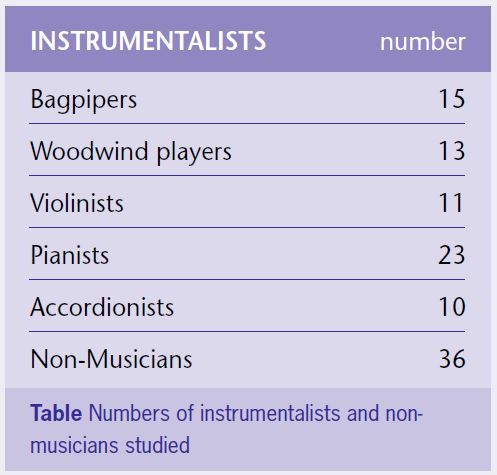
Physiology News Magazine
A physiologist digresses about piping
As a physiologist in Scotland, Geoffrey Walsh cannot miss the potentialities for the study of pipers and piping
Features
A physiologist digresses about piping
As a physiologist in Scotland, Geoffrey Walsh cannot miss the potentialities for the study of pipers and piping
Features
E Geoffrey Walsh
Geoffrey.Walsh@ed.ac.uk
https://doi.org/10.36866/pn.50.24

There are a number of different types of bagpipes (cf Figure 1); when the word is used without qualification it invariably refers to the Great Highland Bagpipe of Scotland. The sound is continuous, there are no gaps; by contrast the Northumbrian pipes are usually played ‘staccato’. The fingers of a piper can move with extreme rapidity, the commonest grace note, ‘High G’, is made by flicking the left index finger, its hole is vented for merely about 20 ms.

For many years I worked in the Edinburgh Medical School and was especially interested in muscles, the way they work and the way they control movements (Walsh, 1992). A physiologist in Scotland cannot miss the potentialities for possible studies of pipers and piping. In my youth I had played no instrument but belatedly, at the age of 47, took up the flute; the basic fingering was not difficult to learn. I found that moving two or more fingers in the same direction at the same time normally was not difficult but moving two fingers in opposite directions, as in a ‘fork’, could be harder. I could find nothing written about this in the scientific or medical literature so built an instrument to make measurements; I have been a radio ham since my youth and like dabbling in electronics. (*1: Call sign GM4FH ) The person was asked to touch one metal button with one finger and at the same instant lift another finger from a second button (Figure 2). With two thumbs and eight fingers there are many permutations and combinations of movement are possible, this allows for great versatility in hand control. The human dominance of the world, for good or ill, has been made possible to a large extent by the extraordinary control by the brain of the hands.

Five years ago, whilst working with Dr Julian Toms at the Health Centre in Portree, Isle of Skye, I met Dr Angus MacDonald, a general practitioner and a piper of distinction, I was amazed that the errors he made on my instrument were much smaller than those I had obtained on medical students in Edinburgh. Intrigued I went to the Piping Centre in Glasgow where the director, Roderick MacLeod, introduced me to six skilled pipers. Similar results were obtained – the errors of the pipers were clearly less than those of the students. Bit by bit I added more data and made measurements on a total of 12 pipers, 127 medical students and 28 young adult classical musicians studying at the Birmingham Conservatoire with the help of Dr Peter Johnson. The errors of the pipers were easily the lowest (Figure 3).

The instruments played by the students at Birmingham were a mixed group; I did not succeed in getting an adequate sample to evaluate the skills of different types of classical musicians. Two years ago I found that in Hanover there is an Institute for Music Physiology attached to a Hochschule where young adults train to reach a high standard as performers (Walsh 2001). It is the – Institut für Musikphysiologie und Musiker-Medizin, Hochschule für Musik und Theater, Hannover. URL- http://sun1.rrzn-user.uni-hannover.de/~n3x3mphy/pages/english1.htm
I got in touch with the director, Dr Eckart Altenmüller, and having by then computerized my arrangements, flew out with a laptop and other apparatus and spent two weeks measuring a variety of different types of finger movement in over 60 musicians. On returning to Edinburgh I ran the same tests on medical students who had never played an instrument, on pipers at the Army School of Bagpipe Music and of the Highland Regiment and on two members of the Glencorse pipe band. The numbers of instrumentalists and non-musicians is given in the Table.

On all of these persons 14 tests were run, the fingers moving in contrary directions to the beat of a metronome at 120/min. The easiest were contrary movements of the two index fingers, the most difficult contrary movements of the ring and little fingers. It is intended to publish the full details else- where. The data files on the computer were subjected to statistical analysis. The results are summarised in Figure 4.

The errors were nearly always of one sort in both the Birmingham and the Hanover studies. When a person attempts to touch one disc and simultaneously to lift another finger it is usual for the finger coming down to reach its target before the other starts to rise, there is ‘overlap’ (cf. Walsh, 1997). For a while both fingers are in contact with the discs. Occasionally the finger coming down has not reached its target before the other has lifted off, both fingers are for a while in the air, there is a ‘gap’. Of the data for Figure 3 only that for the pipers in the lower right panel is negative, indicating a gap. With a woodwind instrument such imperfections lead to the length of the ‘resonant air column’ being for a while incorrect and unless the error is small the music, if being played legato, will be impaired.
The pipe is an extremely responsive instrument. Frictional losses between the moving air and the wall of an instrument are related inversely to the cube of the bore. Thus a practice chanter with a bore of 5 mm will have about 55 times the ‘damping’ of a flute with a bore of 19 mm. These losses increase with frequency. Furthermore, of the instrumentalists I studied, only the pipers normally play out of doors; reverberation as in a room or a hall will be absent and will not mask imperfections in the transition from one note to another.
The sounds of the pipes are rich in overtones, a noteworthy study is that of MacKenzie (1995). The harmonics of the drones extend to 10,000 Hz, the limit of my instrument, and may have components too high for the human ear to hear. This rich spectrum will give the listener a multitude of information about changes of pitch. Piping being in Scotland highly competitive, a good judge may be expected easily to recognize unusually fine skills.
The pipes have two tenor drones both tuned to ‘A’, a base drone tuned to ‘A’ an octave below, ‘Low A’ on the chanter is an octave higher than that of the tenor drones and ‘High A’ is two octaves above the notes on those drones. The acoustics are complex; how is it that after careful tuning the chanters lock together? Even with the best ear a piper will not be able to reach the accuracy of a caesium clock. A Dutch mathematician, Christiaan Hygens (1626-1693), noted that when two clocks were mounted on the same wooden board the pendulae swung at identical rates. Sometimes oscillators (this term can include organ pipes, drones, etc) may fall into step by the transfer of tiny amounts of energy; there is ‘entrainment’. Lord Rayleigh (1842-1919) found that when two organ pipes were fed from the same wind chest the notes became identical. When the reed on one of the drones of a pipe closes, the pressure in the bag will rise and if another reed is nearly opening it is likely to do so at once; So far I have not come across measurements of the pressures in the bag of a bagpipe; the situation with the pipes is more complex than in Rayleigh’s observations because there are four rather than two oscillators, three drones at running sensibly stable frequencies, and the chanter of the notes which are constantly changing.
What happens to the breathing of pipers? To supply the three drones and chanter considerable air flow is needed. When inexperienced persons breathe to the same extent as pipers they become dizzy; some neophytes may faint – experienced performers are free of these effects.
There is a great deal of interest in the science of sport; athletes believe the information helps them improve their performances. By contrast there is an almost complete dearth of information about the ergonomics of playing any musical instrument, a curious anomaly. The equipment used by athletes is for the most part simple, and special study is unnecessary. By contrast the physics of musical instruments is complex; many fine papers may be found in The Journal of the Acoustical Society of America and Acustica.
Acknowledgements
Thanks are due to the numerous people who acted as subjects and to Mr Robert Gibbon for drawing Figure 2.
References
Flood WHG (1911). The story of the bagpipe. Walter Scott, New York.
Gibson TM (1979). The respiratory stress of playing the bagpipes. J Physiol 291 24P.
MacKenzie AC (1995). Some recent measurements on the scale of the Great Highland Bagpipe. Proceedings of the Piobaireachd Society Conference,xxii. Unpaginated.
Walsh EG (1992). Muscles, Masses and Motion. MacKeith. Cambridge University Press, Cambridge.
Walsh EG (1997). Synchronization of human finger movements: delays and sex differences with isotonic antiphase motion. Exp Physiol 82, 559-565.
Walsh EG (2001). Musicians and physiologists . The Physiological Society Magazine 42. 8-9. Walsh EG (2003). Scientific tests prove pipers surpass all others in fingering. Piping Times 55(4), 21 et seq.
Watson AWS (1979) Some observations on the respiratory effort of bagpipe playing. J Physiol 227, 3-4P.
